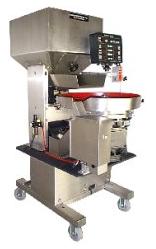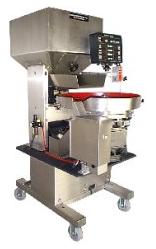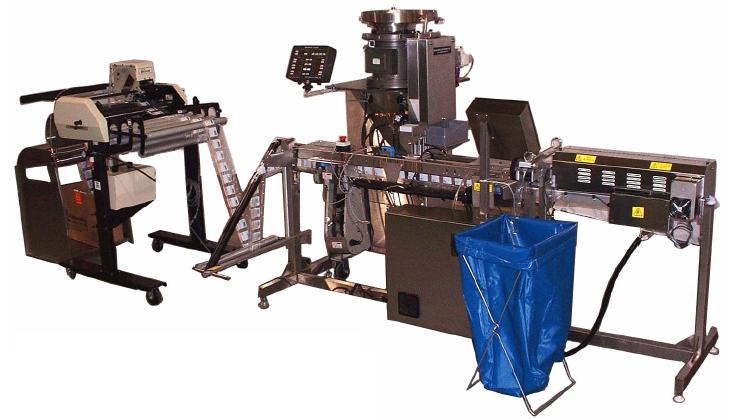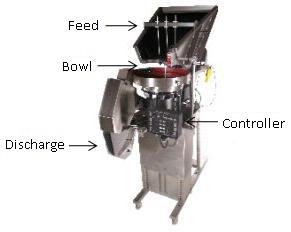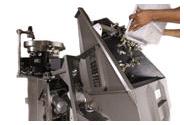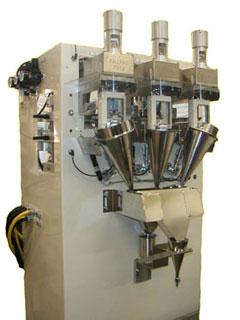Batching equipment is used to transfer specific quantities of material to a transport vessel or packaging unit.
General Information
Batching processes are used in many industries. Batchers, such as the one shown below, are designed to sort materials based on weight or number. They can also be designed to package products.
Equipment Design
Batching systems are quite similar in function and appearance. They include a feed element, a bowl, a controller, and a discharge section, described below.
Conveyors and elevators typically transport material from other processes. The material then enters the batcher through the feed.
Conveyors and elevators transport the material from other processes. The material then enters the batcher through the feed. See the Conveyors section of the encyclopedia for more information.
The controller controls the amount of material passing through the machine. It ensures that the machine dispenses the required weight of number of material for each batch.
The bowl is where the material is temporarily contained before being sorted. It is usually vibratory, with the intensity of vibrations being monitored by the controller. Baggers do not typically have a bowl.
The material is discharged through the bottom of the equipment. The batches are then bagged or transported to other processes.
Three types of batching equipment are described in the next sections: weighing, counting, and bagging.
Weighing
The most common type of batching equipment separates material into constant weight portions.
These devices can weigh one or several ingredients simultaneously or sequentially. The processes can operate automatically, semi-automatically, or manually. Traditionally, manual systems use pre-weighed bags which leads to errors since the bags have to be filled and emptied repeatedly. Automatic and semi-automatic systems are more accurate and precise than manual systems which ultimately results in an improved overall product.
There are two methods that can be used with automatic systems: gain-in-weight and loss-of-weight. The gain-in-weight method uses load cells and a programmable logic controller to start the conveyor and stop it when the specified weight is reached. The loss-of-weight method uses the same load cells and programmable logic controller to stop the valve when the specified weight has passed through the load cells. Gain-in-weight systems are used for the weighing or a large number of small-volume materials while loss-of-weight systems are used for a small number of large volume materials. If some batches are out of tolerance, then the machine will reject them, and they will not continue on to be bagged.
Load cells are responsible for maintaining this tolerance and are used in automatic batching from 10 kg to over a few metric tons. Load cells vary in weight ranges and in that range they will be most accurate. For example, a heavy range load cell would not be very accurate or precise for lightweight measurements. Load cells need to be frequently calibrated to ensure that the measurements are precise since they are regularly under stress.
Counting
Another type of batching equipment is a counting device. These systems are particularly useful for larger solids of varying size.
The batcher shown here is used to count tablets. It can either count by number or count by volume. This batcher also counts how many full, partial, and oversized tablets go through the machine, which is important to know for quality records.
Bagging
Bagging devices are also used in batching processes. Baggers first form a bag, then fill and seal it. They are typically used in the final packaging of a product. This picture shows a typical bagging device. It is used to package objects such as candy, bolts, toys, or frozen food.
Usage Examples
Weight batchers are used to sort objects of the same size and weight. They are used primarily in the pharmaceutical, chemical, and agricultural industries. The weighing system shown below is used to measure powder material from 25 mg to 1 kg. The system operates automatically to fill containers with a preset weight of material.
Batch counters are most widely used to count bulk solids. They can handle solids of varying size and weight within the same batch. Counters are used in the plastics industry for larger products, in the pharmaceutical industry for tablets, and in the food industry, as shown below.
Baggers are used to bag anything from granules of sand to large pellets of material to larger objects, as shown below. They are used in the mining, agricultural, pharmaceutical, and plastics industries.
Advantages
- Several types of batching equipment can be used together in a system.
- Weighers can typically be designed to batch several different ingredients simultaneously or sequentially.
- Counters are able to batch objects of varying size and weight.
- Baggers will usually be able to fill bags of different sizes with little or no change in controls.
Disadvantages
- Many weighers need to stop between processes.
- Counters cannot always accurately count shiny or thin pieces.
Acknowledgements
- Batching Systems, Inc., Owings, MD
- FillPro, Inc., Golden, CO
References
- Brandl, Dennis. “Making Batch Plants Bloom,” Chemical Engineering, June 1998: 72-79. Print.
- Jenkins, Scott. “Facts At Your Fingertips: Automated Weigh-Batching Systems.” Chemical Engineering. July 2012: 24 Print.
Developers
- Katie Clise
- Kelsey Kaplan
- Thomas Plegue

